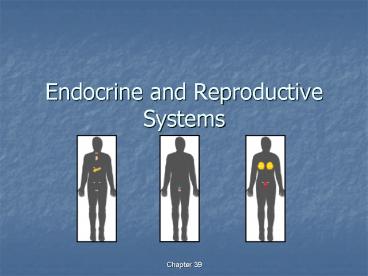Endocrine and Reproductive Systems - PowerPoint PPT Presentation
1 / 20
Title:
Endocrine and Reproductive Systems
Description:
Endocrine and Reproductive Systems Endocrine System Made up of glands that release hormones into the bloodstream Hormones: chemicals used to broadcast messages ... – PowerPoint PPT presentation
Number of Views:68
Avg rating:3.0/5.0
Title: Endocrine and Reproductive Systems
1
Endocrine and Reproductive Systems
2
Endocrine System
- Made up of glands that release hormones into the
bloodstream - Hormones chemicals used to broadcast messages
- Bind to specific chemical receptors Target Cells
3
Controlling the Endocrine SystemFeedback
Inhibition
- Regulated by feedback mechanisms that function to
maintain homeostasis - Negative feedback
- This means that the glands that stimulate the
release of a hormone (for example, the pituitary)
from another gland (for example, the thyroid) are
eventually shut off, in a sense, so that too much
hormone is not produced. - Like an a.c. thermostat at home
4
Endocrine Glands
- Glands that release hormones directly into the
blood stream.
5
- Pituitary gland
- Located in the skull
- Secretes 9 hormones that regulate many body
functions - controls the actions of several endocrine glands
- Hypothalamus
- controls the secretions of the pituitary gland
- These structures work together
- Allows the nervous endocrine systems to work
together - Coordinates body activities
6
Pituitary Gland Hormones
7
Thyroid Parathyroid Glands
- Major role regulate metabolism
- Makes thyroxine, which affects metabolic rates of
cells - Hyperthyroidism too much thyroxine
- Nervousness, elevated body temp., increased
blood pressure, weight loss - Hypothyroidism too little thyroxine
- Lack of energy, weight gain, goiter
- Hormones from the thyroid gland and the
parathyroid glands maintain homeostasis in blood
calcium levels
8
- Adrenal glands
- help the body prepare for and deal with stress by
releasing hormones - Responsible for fight or flight
- Epinephrine, Norepinephrine
- Pancreas
- Releases insulin and glucagon
- helps to keep the level of glucose in the blood
stable
9
- Gonads the bodys reproductive glands
- Female ovaries
- Produces eggs, and sex hormones
- Estrogen responsible for producing eggs and the
formation of physical features associated with
the female body - Progesterone prepares the uterus for the arrival
of a developing embryo - Male testes
- Produce sperm and testosterone
- Testosterone is responsible for producing sperm
and the formation of physical features associated
with the male body
10
The Reproductive System
- Male Structures
- Testes
- Within each testis are
seminiferous
tubules where
sperm are produced - Scrotum houses the testes
- Epididymis where sperm
fully matures
and is stored - Vas deferens connects the epididymis to the
urethra - These structures work together to produce and
deliver sperm
11
The Reproductive System
- Female Structures
- Ovaries houses
immature eggs. Once
an egg matures (1 every 28 days) it travels
down the - Fallopian tubes during its journey through the
fallopian tubes an egg can be fertilized - Uterus receives the fertilized egg
- Main function produce eggs. Secondary to
prepare the female's body to nourish a developing
embryo
12
Menstrual Cycle
- If an egg is not fertilized, it is discharged
along with the lining of the uterus - 4 phases
- follicular phase 10days follicles (cell
clusters) that surround the egg develop, the
lining of the uterus thickens with nutrients - Ovulation3-4days a mature egg is released
- Luteal phase greatest chance of fertilization
- Menstruationif the egg is not fertilized, then
the unfertilized egg and the uterine lining are
discharged through the vagina
13
(No Transcript)
14
Fertilization Development
- The process of a sperm joining
with an egg is called fertilization - Sperm Egg Zygote
- Once the zygote forms, it undergoes mitosis
- 6-7days after fertilization,
the embryo becomes a
cluster of
cells with a
hollow center
a blastocyst
15
Stages of Early Development
- Implantation
- When the blastocyst attaches itself to the
uterus - Differentiation begins when cells begin to
become specialized
16
Stages of Early Development
- Gastrulation
- The blastocyst forms 3 layers
- Ectoderm develops into skin and nervous system
- Mesoderm develops into internal tissues organs
- Endoderm lining of digestive system and its
organs
17
Stages of Early Development
- Neurolation
- Development of the nervous system
18
Extraembryonic Membranes
- During embryo development, mebmbranes develop to
protect and nourish it - Amniotic sac fluid-filled sac that cushions and
protects the embryo in the uterus - Placenta the embryos organ of respiration,
nourishment, excretion
19
Development
- After 8 weeks the embryo is a fetus
- 3 months major organs, tissues, muscles, and
umbilical cord have formed - Months 4-6 tissues become complex and
specialized, AND begin to function - Hear a heartbeat, bone continues to replace
cartilage, hair growth, movement - Months 7-9 organ systems mature, fetus doubles
in mass, can regulate his/her own body
temperature, the lungs and CNS begin to change in
preparation for the outside world
20
Embryo ? Fetus
Embryo 5-6 Weeks
Fetus at 14 weeks
Fetus at Full Term































